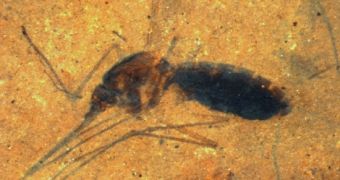A paper published in yesterday's issue of the journal Proceedings of the National Academy of Sciences details the discovery of a 46-million-year-old fossilized mosquito whose belly contains traces of blood.
Unlike the fossilized blood-filled mosquito in “Jurassic Park,” this insect was not found in amber, but in shale gas sediments in Montana, information shared with the public says.
By the looks of it, the female mosquito died shortly after enjoying one last meal. Hence the fact that its belly looks as if it were about to burst.
“The present study describes the fossil of a blood-engorged mosquito in oil shale from northwestern Montana. The existence of this rare specimen extends the existence of blood-feeding behavior in this family of insects 46 million years into the past,” researchers commented on importance of the discovery of this fossilized insect.
Scientists say that, all things considered, the discovery of this insect is nothing short of impressive. This is because a mosquito's body is incredibly fragile, and the chances that it will remain intact for millions of years are slim to none.
“The abdomen of a blood-engorged mosquito is like a balloon ready to burst. It is very fragile. The chances that it wouldn’t have disintegrated prior to fossilization were infinitesimally small,” explained Dale Greenwalt with the US National Museum of Natural History, as cited by Nature.
“This shows that details of a blood-sucking mosquito can be nicely preserved in a medium other than amber,” added George Poinar with the Oregon State University in Corvallis.
Investigations have revealed that the mosquito's engorged tummy contains traces of both iron and an organic molecule known as porphyrin.
Both iron and porphyrin are part and parcel of hemoglobin, a compound that is present in the blood of vertebrates and which is in charge of transporting oxygen, specialists explain.
Unfortunately, whatever foreign DNA entered the female mosquito's body while it was busy gulping down blood appears not to have stood the test of time. This is because DNA molecules are very fragile, and therefore highly unlikely to survive fossilization.

 14 DAY TRIAL //
14 DAY TRIAL //